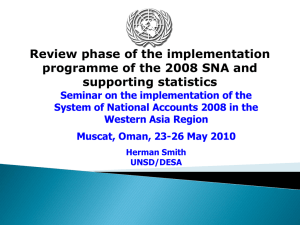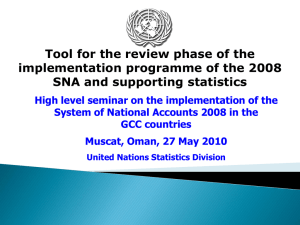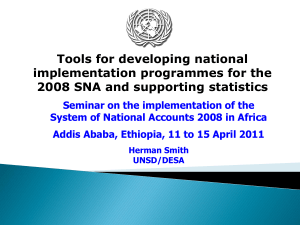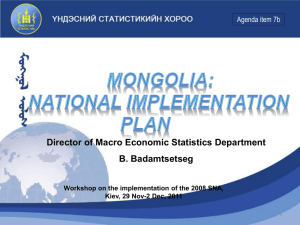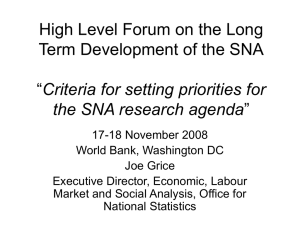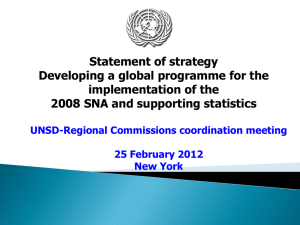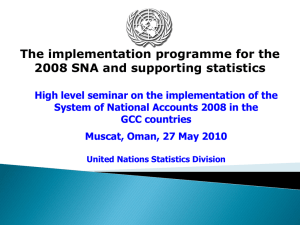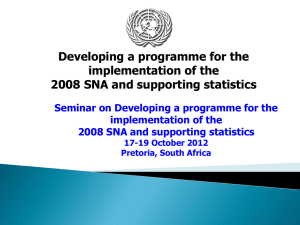Review phase of the implementation programme of the 2008 SNA and
advertisement
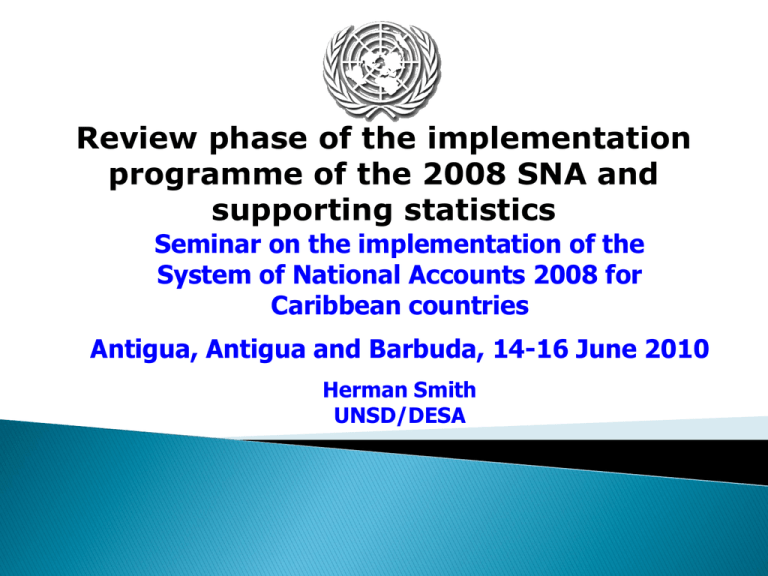
Review phase of the implementation programme of the 2008 SNA and supporting statistics Seminar on the implementation of the System of National Accounts 2008 for Caribbean countries Antigua, Antigua and Barbuda, 14-16 June 2010 Herman Smith UNSD/DESA Outline of presentation Introduction Strategic planning framework Knowledge base for economic statistics and macro economic standards Diagnostic framework for national accounts and economic statistics Strategic planning framework Strategic planning Strategic planning is a key principle in mobilizing political and financial support for investment in statistics to connect national development objectives with a programme of work for statistical capacity-building. For this purpose a strategic planning framework need to be developed Strategic Planning Framework Best practices are available on how to develop SPFs for the development of statistics: National Strategies for the Development of Statistics (NSDSs) is the most widely used tool for statistical planning in developing countries ISWGNA favours the use of NSDS strategic planning framework A NSDS is a guide for developing a statistical system ◦ Coordination and sequencing ◦ Consistency with national priorities and the needs of data users A sequenced set of actions to be carried out over a period of 4 to 5 years 1. 2. 3. 4. 5. 6. Integrated into national development and poverty reduction policies; Takes into account national, regional, and international data needs; Encompasses production, dissemination, analysis, and use of data and related issues; Covers all the main statistical production units, and serves as a framework for sectors; Serves as coordinating framework for international and bilateral assistance; Integrates existing activities, and draws on the past experience Resources are limited, and priorities have to be made Piecemeal approach is not cost effective To ensure that all areas are covered To promote alignment with national policy priorities and plans Five phases ◦ Launching the process (road map) ◦ Assessment ◦ Developing the vision ◦ An implementation plan ◦ Managing implementation and monitoring progress The timetable depends on a number of factors: ◦ Political validation ◦ What is already in place ◦ Need for sufficient time for effective consultation and review Important to link preparation with national processes and budget timetables ◦ Who decides? The national authorities. ◦ ◦ Who leads the work? A central team assisted by other teams. ◦ Who advises? Specialists and users. ◦ Who provides technical and financial support? International and regional co-operation Assessment and appraisal of existing outputs Strategic vision Includes institutional development, framework Implementation plan ◦ Cost, realistic, prioritized, timetable, flexible Statistical system ◦ ◦ ◦ ◦ ◦ Frameworks (regulatory, codes of practice) Statistical infrastructure Methods Coordination & prioritization mechanisms Products (“national statistics”) Statistical agencies ◦ Business or corporate plans ◦ Short-term work plans Data development requirements for national accounts should be an integral part of the NSDS NSDS sometimes lack of emphasis on economic statistics Priorities not reflecting the needs of data users Fully developed - include sequencing, costing, and human resource implications NSDS not the result, but the means to achieve goals Knowledge Base on Economic Statistics and Macroeconomic Standards Part of the 2008 SNA implementation strategy Provide a centralized repository of information on all aspects of methodology and best country practices for the collection, analysis and dissemination of all areas of economic statistics and macroeconomic standards Facilitate the international sharing and exchange of knowledge on economic statistics programmes as well as the provision of guidance to countries Serve as a single web-based access point by combining information made available by various sources and by optimizing the collection, organization, and display of all stored information Rationalize and streamline information finding Main target: Statistical community in developing countries Is not a static collection of information, but a dynamic resource User interaction, which distinguishes it from any basic or complex search engine Guarantees easy maintenance Information is presented coherently throughout the system Information is constantly monitored and updated without delay Knowledge base allows users to look for information in two ways: (1) by conducting a search or (2) by browsing through the pre-defined structure Conduct a search: User already knows what he/she is looking for User can locate the relevant document through appropriate keywords or tags Fast retrieval of information (Search function performed as full-text search, including search within PDF format) Contain 23 different statistical domains Includes more than 250 documents Best practices available for more than 27 countries Countries are invited to actively participate by adding relevant documents http://unstats.un.org/unsd/econstatkb Diagnostic framework for national accounts and supporting statistics Purpose Tool to assess the adequacy of the national statistical production process to support implementation of the 2008 SNA. Self assessment of statistical prerequisites outlined in stages I and II of the 2008 SNA implementation programme. Develop a vision for improving the availability and quality of the economic statistics required for compilation of national accounts. Purpose Discuss vision preferably in a national seminar with all stakeholders, such as: ◦ policy planners; ◦ users including the academia; and ◦ business community. Purpose Such a discussion is expected to help the NSO to: ◦ prioritize actions to mitigate the problem areas ◦ write a plan for the improvement of the supporting statistics for the compilation of the national accounts ◦ develops an information structure for planning, monitoring and evaluating the implementation of the SNA; and ◦ builds on the joint efforts of the ISWGNA to establish an information structure for managing technical assistance operations Approach The tool is based on the widely used CES Classification of Statistical Activities The Classification provides a structured presentation of statistical activities aimed at ◦ ◦ ◦ ◦ collecting, producing and disseminating data, developing standards, harmonization and implementation of statistics. Statistical activities are organized in five statistical domains. Approach Domains 1-3 deals with the outputs of the statistical process. ◦ 1 Demographic and social statistics; ◦ 2 Economic statistics; and ◦ 3 Environment and multi-domain statistics Domains 4 and 5 cover substantive issues such as process, organization and also managerial aspects of official statistics. Approach 4 Methodology of data collection, processing, dissemination and analysis Deals with activities that lead to statistical outputs covering: ◦ data collection, processing and dissemination methodology, and ◦ activities for producing official statistics such as censuses, surveys, administrative registers. Approach 5 Strategic and managerial issues of official statistics covers areas that are of managerial concern, dealing with the institutional and organizational side of national and international statistical agencies, which includes ◦ the management, coordination of the statistical system, including relationship with users, organization of the statistical office, ◦ promotion of official statistics, ◦ setting up national statistical programmes, ◦ human resources management and training and ◦ ICT management. Diagnostic tool Cross classify the statistical activities of domain 2 and selected activities from domain 1 and 3 with domain 4 and 5 This allows the assessment of economic activities in terms of ◦ process, ◦ organization and ◦ managerial aspects of official statistics Statistical System Information Another tool to assist in the development of national implementation programmes The statistical system information was obtained from the web This tool brings together information available at various sources into a single framework. Statistical System Information Country Statistical agency Legal Framework Strategic Framework Relevant documents Projects/Programmes Data Statistical Standards UNSD, IMF, World Bank, Eurostat, Paris21 Relevant documents Data SNA implementation website To facilitate sharing of information UNSD is in the process of developing a website with information supporting the implementation of the 2008 SNA and supporting statistics. SNA implementation website Themes that could be addressed in this website are: ◦ Knowledge base on statistical standards and guidance material (already operational) ◦ Knowledge base on training material (still under discussion) ◦ Progress with the implementation process, which could include Statistical system information Results of the diagnostic tool The vision documents Progress reports Thank You
